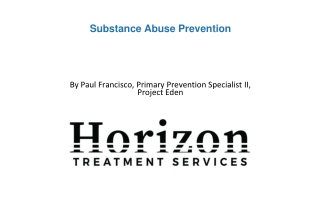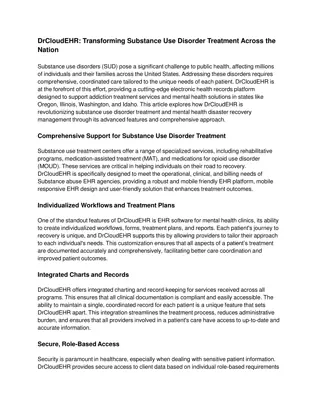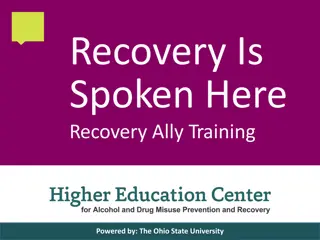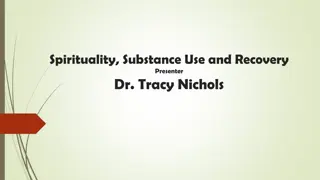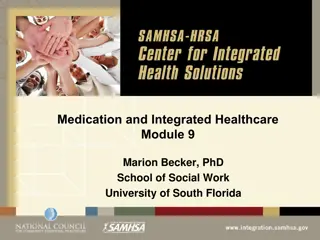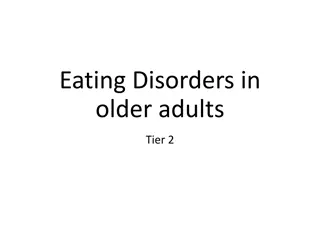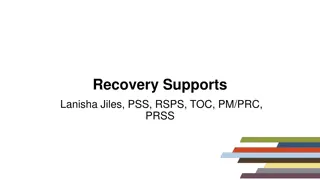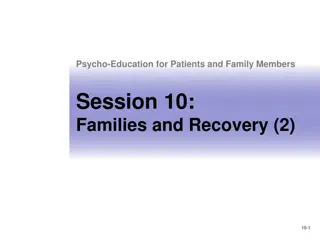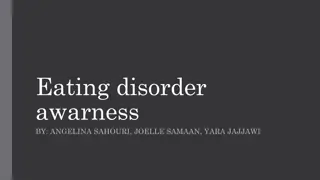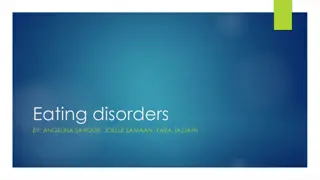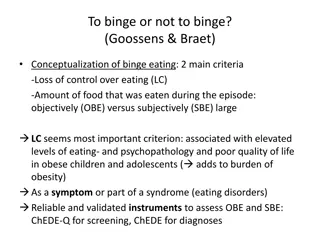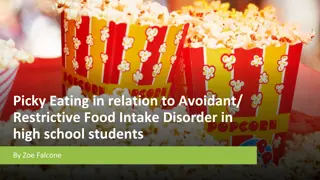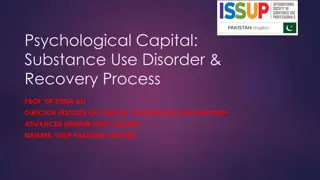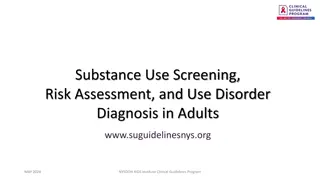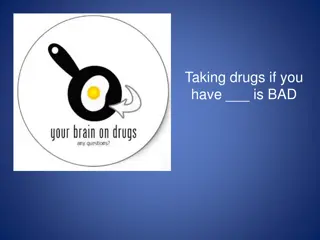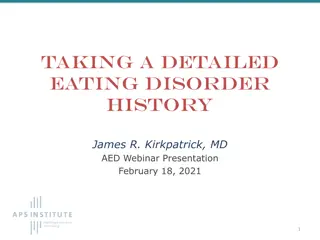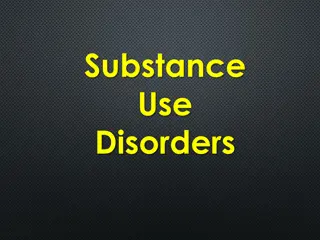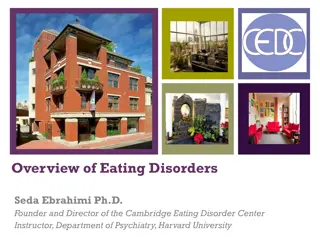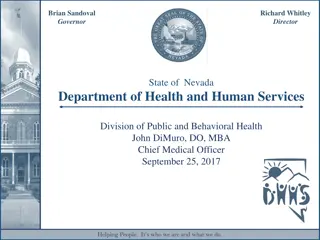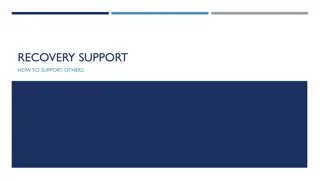Uniting Eating Disorder and Substance Abuse Communities in Recovery
This presentation explores the intersection of eating disorders and substance abuse disorders, highlighting the similarities and differences in personality types. It delves into the high co-occurrence rates of these disorders, providing evidence for incorporating a 12-step approach to aid in recovery. By understanding these shared challenges, barriers to utilizing the 12-step approach can be addressed effectively.
Download Presentation

Please find below an Image/Link to download the presentation.
The content on the website is provided AS IS for your information and personal use only. It may not be sold, licensed, or shared on other websites without obtaining consent from the author.If you encounter any issues during the download, it is possible that the publisher has removed the file from their server.
You are allowed to download the files provided on this website for personal or commercial use, subject to the condition that they are used lawfully. All files are the property of their respective owners.
The content on the website is provided AS IS for your information and personal use only. It may not be sold, licensed, or shared on other websites without obtaining consent from the author.
E N D
Presentation Transcript
Hungry for Community: Applying a 12 step approach to eating disorder Applying a 12 step approach to eating disorder recovery recovery Presented by: Kris Shock, CACII, CPS
Objectives: Identify the differences and similarities in personality type of those with a diagnosis of eating disorder versus those with substance abuse disorder Understand evidence to support incorporation of 12 step approach to eating disorder recovery and application of a 12 step recovery for those with eating disorders Apply knowledge of differences and similarities in order to address barriers to utilizing 12 step approach in eating disorder recovery.
Identify the differences and similarities in those with a diagnosis of eating disorder versus those with substance abuse disorder
Are these even two communities? A 2010 review found that both clinical and community studies have reported high co-occurrence of EDs among women with SUDs.3 For example: Gadalla and Piran found that women with either an SUD or an ED were more than four times as likely to develop the other disorder as were women who had neither disorder. Gilchrist and colleagues examined the co-occurrence of EDs and SUDs and reported that 14 percent of women with an SUD had AN and 14 percent had BN. Substance Abuse and Mental Health Services Administration. (2011). Clients With Substance Use And Eating Disorders. Advisory, Volume 10, Issue 1.
Similarly, Hudson and colleagues8 found that men and women with EDs had high rates of co-occurring SUDs (Exhibit 6). Piran and Robinson looked at the relationship between EDs and SUDs and found that: As EDs became more severe, the number of different substances used increased. Severe BED was consistently associated with alcohol use. Attempts to lose weight by purging (with or without binge eating) were associated with stimulant/ amphetamine and sleeping pill (e.g., triazolam, flurazepam) abuse. Substance Abuse and Mental Health Services Administration. (2011). Clients With Substance Use And Eating Disorders. Advisory, Volume 10, Issue 1.
Exhibit 6. Lifetime Comorbidity Estimates of Eds and SUDs Disorder Disorder Alcohol Abuse or Alcohol Abuse or Dependence (%) Dependence (%) Illicit Drug Abuse Illicit Drug Abuse or Dependence or Dependence (%) (%) 17.7 Any Substance Any Substance Use Disorder (%) (%) Use Disorder Anorexia Nervosa 24.5 27.0 Bulimia Nervosa 33.7 26.0 36.8 Bing Eating Disorder 21.4 19.4 23.3 Substance Abuse and Mental Health Services Administration. (2011). Clients With Substance Use And Eating Disorders. Advisory, Volume 10, Issue 1.
Similarities Common Brain Chemistry- Dopamine Familial History Emerge in times of stress and transitions Low Self esteem High levels of depression, anxiety, shame/guilt Societal pressures History of trauma Medical complications
Differences Gender differences Age differences Treatment approaches Definition of recovery
Understand evidence to support incorporation of 12 step approach to eating disorder recovery and application of a 12 step recovery for those with eating disorders
What does the research say about using a 12 step approach to ED treatment? McAleavey, Kristen, (December 2010). Short- Term Outcomes of a 12-Step Program among Women with Anorexia, Bulimia, and Eating Disorders. Journal of Child & Family Studies 19:728 737. Linville, Deanna; Brown, Tiffany; Sturm, Katrina; McDougal, Tori, (May/Jun 2012). Eating Disorders and Social Support: Perspectives of Recovered Individuals. Eating Disorders 20(3): 216- 231.
Much research is to be done Published reports concerning the use of a 12-Step in ED programs are scant. Most studies are generally theoretical or experiential rather than empirical in orientation, or have employed limited samples and, thus, cannot be generalized to the larger population (Miller 1995). Few are also longitudinal in focus, representing yet another limitation. (McAleavey, 2010)
A 12 step approach is an avenue to provide aftercare where insurance and/or resources may limit aftercare otherwise Coleman (2003) and others have forcefully argued that because of the nature of eating disorders this type of ongoing aftercare is a vital component in life-long, permanent recovery and maintenance of desired eating behaviors. Aftercare is also regarded as having the capacity to reinforce behavioral and attitudinal changes brought about, during primary intervention, and to provide the type of support needed to maintain these changes. This might very well be the key element in the recovery process. (McAleavey, 2010)
The principles of 12 steps encourage connection to others sharing same experience Based on the data from the current study, eating disorder recovery is influenced by the individual s connection to self and others, their relationships, and the focus of care. Participants reported needing reconnection, both internally and externally, and explained that these connections played a role in their overall recovery experience. Participants discussed a need for treatment and recovery to focus on more than just their weight and to include an emphasis on overall health and well-being. Eating disorder recovery, according to the participants of this study, is greatly influenced by those around the individual struggling with an eating disorder. (Linville, Brown, Sturm & McDougal,2012)
And more needs addressed within the 12 steps Hindered Recovery Aided Recovery Reconnections Close Relationships Statements of Support Empathetic Friends Compassion Understanding Providers Therapy Learning how to eat healthy Education on effects of the disorder Trivializing the disorder Hyperfocus on eating Not overtly commenting about the disorder Isolation Being stereotyped and stigmatized Patronizing providers Hurtful comments about weight Weight as recovery barometer Being Weighted (Linville, Brown, Sturm & McDougal,2012)
The power of the shared experience: There are few alcoholics who cannot identify with Bill even after so many years. Participants talked passionately about wanting social supports to notice them, connect with them, be a stable presence and not ignore or minimize their eating disorders. (Linville, Brown, Sturm & McDougal,2012)
Apply knowledge of differences and similarities in order to address barriers to utilizing 12 step approach in eating disorder recovery.
Use the value of community and acceptance (need to improve self worth) to sell the 12 steps
Differences that create barriers: Gender specific 12 step groups Utilize the knowledge of common treatment modalities such DBT and CBT by drawing similarities to 12 steps Incorporate the usage of the EDA big book and the AA big book so that the differences in the concept of recovery is understood.


